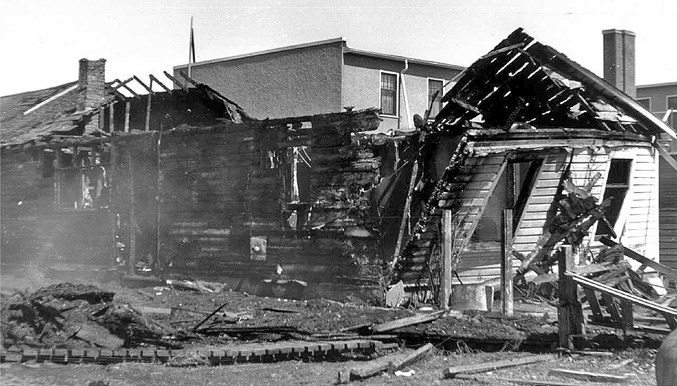Fire wiped out almost a dozen buildings in a monumental event that shook Black Diamond residents 70 years ago.
April 24, 1949 brought with it 100-kilometre per hour winds that whipped through the then village, and when fire erupted on the south side of Main Street several buildings didn’t stand a chance.
“It was a fireman’s nightmare,” exclaimed Ken Atkins in the history book In the Light of the Flares. “It took many years to rebuild the damage done to the town that day.”
Atkins, who served as fire chief from 1946 to 1981, was quoted as saying it was fortunate the dwellings on the west side of the street were saved and no serious injuries or death occurred.
At that time, Black Diamond was a village of around 1,000 people with no water services and some fire equipment.
In 1930, Black Diamond council approved, after lengthy discussion, the purchase of a Du-Gas 10 gallon, two-cylinder fire engine for $550, a dozen fire buckets and a 32-foot extension ladder.
Sixteen years later, the Village borrowed money to purchase a crash truck for $3,605.03 and a fire brigade was set up at that time.
There had been a lot of protesting from taxpayers about the Village spending so much money on the truck.
Previously, when a building caught fire it usually meant it burned down. If the fire endangered another building, a call was made to Imperial Oil for a truckload of water.
When fire broke out in the Joe Riley Transport office and garage warehouse east of the Winston Theatre at around 5:30 a.m. that Sunday, Atkins and 16 firefighters responded.
When they arrived, the warehouse was engulfed in flames that were out of control and fire was spreading to the neighbouring buildings. A call went out to nearby fire departments, with the Okotoks department and Royalite Oil Company responding.
Fire trucks were supplied water by 12 local water trucks that were equipped with pumps to draw water from the Sheep River.
Atkins described it as a long, hard fight, with firefighters battling wind and flames all morning. He said the fire was brought under control at noon after it demolished a good portion of the south side of Main Street.
Damages were estimated at over $200,000. According to the Bank of Canada’s inflation calculator, that would equate to more than $2 million today.
Buildings destroyed included the Winston Theatre, a modern one-storey brick building, Black Diamond Transport, the district Calgary power office, a photography shop, beauty parlour, The Style Shoppe, three-storey rooming house, The Welcome Inn and Webber’s Grocerteria and Dry Goods.
Webber’s Grocerteria and Dry Goods store owner Albert Webber stated in In the Light of the Flares that he didn’t awaken until the building was on fire.
“I found my clothing and put it on and by the time I had dressed my pajamas had burned,” he said. “I woke my wife Elaine and my six-year-old daughter and my mother-in-law Lucy Cuthbert and we got out safely.”
Lloyd Hicklin also spoke of his experience when flames shot into his family’s suite at the rear of The Style Shoppe. The family ran through the store in their bare feet, which were burned and cut. Emily Hicklin had to be hospitalized.
Twenty people at The Welcome Inn were awakened by the fire and fled the building, escaping injury but losing their possessions.
Black Diamond residents stepped in with pails of water and wet sacks to keep the rest of the town from burning.
Dozens of small grassfires erupted and rooftops caught fire on many buildings. In a nearby lumberyard, 500 yards to the east of the blaze, stacks of lumber were threatened by flying sparks because burning boards were flying through the air and landing as far as a half mile east of town.
Damage was also done to buildings on the north side of Main Street from flying debris and windows breaking from the heat.
Atkins wrote that the blaze left a great void in the village, which would have been worse without a fire department.
Jamie Campbell, who’s served as Black Diamond’s fire chief for 32 years, said a lot has changed for firefighters since then, from training to resources to protective gear.
“Back then you didn’t have the gear we have now, which has got vapour and thermal barriers,” he said. “Back then they wore long leather jackets.”
Today, firefighters are equipped with a coat, pants, leather boots, gloves and breathing apparatus, all created to stand the heat of a fire.
“In the days of old, a guy in the hardware store threw his apron on the counter and went to a call,” Campbell said. “Now there’s more stringent occupational health and safety regulations for firefighters.”
Campbell said the 1949 fire is probably the largest multi-structural fire ever in Black Diamond.
“Some of those buildings in the downtown are still pretty old,” he said. “If they light up and we have the right conditions we would be hard pressed to put them out, but we have modern equipment now. Our trucks can pump 2,000 gallons a minute. That’s a lot of water.”
Details for the story were obtained from the “In the Light of the Flares” book.




.JPG;w=120;h=80;mode=crop)